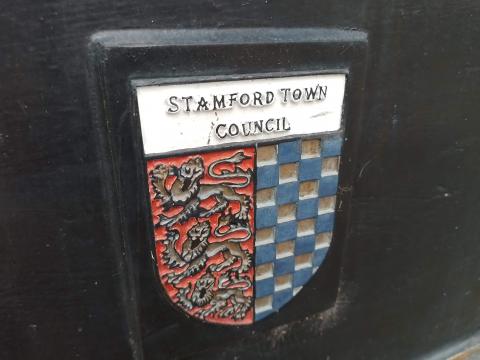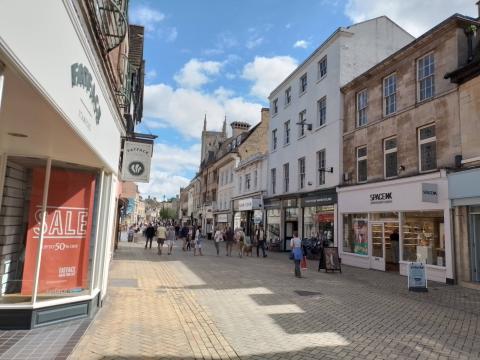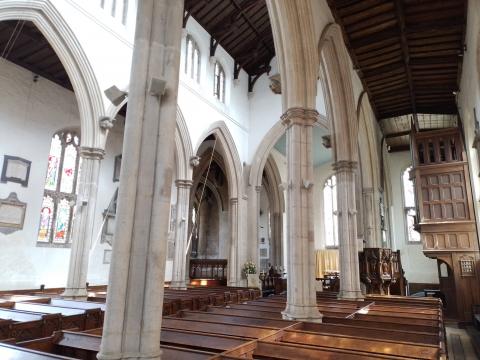Wistful in Stamford

On Tuesday I was in Stamford, the well-heeled and genteel Lincolnshire market town. I wished to view the local churches (it appears to have 6 medieval structures, 5 of which are open to the public) as well as a good range of shops and eateries. It seemed all quintessentially English; elegant, traditional, beautiful and stable. Middle-aged men in chinos and Panama hats strolled down the high street; women in printed, floral dresses handed ice-creams to deserving children; pubescent boys and girls sat on walls laughing at each other’s jokes.

It was my second visit to the town, my first as a teenager back in 1995. I dimly recollect sharing a coach holiday with my late grandmother, for which Stamford must have been one of the stops. I recall wandering off on my own in order to call at St Martin’s church, a large and impressive medieval structure sitting by the main road. I had but 15 minutes before I had to return to the coach (and woe betide any coach traveller who delays his fellow passengers for want of punctuality). I think this was the beginning of my long love affair with ecclesiastical architecture, the first ‘church-grab’ of my career. Furthermore, I met the then incumbent, the Rev Nigel Gibson, who took an interest in this visiting 16-year-old who seemed to be overawed by his building. Although we exchanged a couple of letters afterwards, I have had to look him up to recall his surname. I had advised him that I was hoping to begin A-levels the following month and that I was considering reading theology at university. The good parson was kind and encouraging, and I remembered his smiling face, if not his name, for nearly thirty years.

Standing in that old church again this week, almost 28 years to the day, I was rather emotional. I reflected on the younger me occupying that same spot. I unrealistically hoped that the old visitors’ book was still employed, so I might flick back the pages and see a younger Marsden’s earnest scrawl. Interestingly, I stopped wearing shorts after I was 16, and only wore them again from last year. So in some respects, there was a pleasing sense of continuity. Observers of sartorial fashion will know that the centre-parted hair styles, baggy jumpers and mid-blue, loose-fitting jeans are as much worn by young men today as they were back in the mid-nineties. Likewise, a long period of Conservative administration was then, and now, looking likely to be swept away by a reinvigorated and more re-electable Labour Party; so business as usual, life going on. And still old St Martin’s gazes down on the comfortable burgesses of Stamford, and its goggle-eyed tourists from the northlands.
Yet I had changed. Back in ’95, my whole life was ahead of me. Ambitions were being formed, aspirations nurtured. In 2023, they were either fulfilled and worthy of a shrug, or they remain unfulfilled, an expression of failure, a personal catalogue of disappointment. For 28 years of additional breath, I am not sure that I have very much to show. I suspect that this is what ancient buildings do; this is the mysterious effect they have on the soul. St Martin’s church witnessed admiring young men being wowed by its arches and tombs not just in 1995, but in 1895, 1795, 1695, 1595, and 1495 (the current building goes back no further). Centuries’-worth of wide-eyed, middle-aged men have assessed their lives in the shadow of this edifice. Apart from some lucky entrepreneurs who strike gold, or plump matriarchs of extensive broods which have safely and successfully flown the nest, few of us evaluate our lives with any heightened sense of contentment or satisfaction. If it is my love of old churches which allows me to see this, then it is a hobby well worth having.

As I concluded my photographs and re-signed the visitors’ book, I departed from the place with a sense of wistfulness bordering on melancholy.
The antidote to such feelings, which may or may not be deserved and rational, is to look ahead to all that is promised to the Christian in Christ. The past is seldom glorious, and the present rarely offers advancement. Yet in Christ, the future is always bright and splendid. The so-called ‘thief on the cross’ wasted his life on thuggery and greed, but He was promised citizenship of a glorious kingdom perhaps minutes before he died. The New Jerusalem described in the final chapters of Revelation paints a picture of heaven’s wonder. Such joy as it affords will make even the dullest nonentity and unaccomplished bloke the happiest and satisfied man there is.

To them God willed to make known what are the riches of the glory of this mystery among the Gentiles: which is Christ in you, the hope of glory. Colossians 1:27, NKJV
- Log in to post comments


 Sunday Worship 10.45am & 6.00pm
Sunday Worship 10.45am & 6.00pm